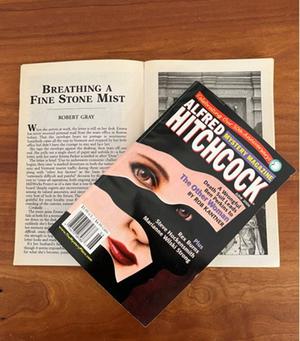
I have my doubts about whether Hitchcock would have made a great bookseller, but one of his favorite haunts was Argonaut Book Shop, an antiquarian bookstore specializing in the history of California and the American West. Located on Kearny St. at the time of the film's production, it eventually moved to Sutter St. Argonaut was opened in 1941 by Robert Haines, who became a friend of Hitchcock's. After Haines died in 1980, his son, Robert Haines Jr., took over the store.
 Vertigo's Argosy Book Shop was constructed at Paramount Pictures studios, but the interiors were modeled after the real Argonaut Book Shop. According to the book Footsteps in the Fog: Alfred Hitchcock's San Francisco by Jeff Kraft & Aaron Leventhal, "the junior Mr. Haines is convinced that Hitchcock borrowed mannerisms from his father for the character of Pop Leibel, particularly the way in which Leibel lit and smoked his cigarettes."
Vertigo's Argosy Book Shop was constructed at Paramount Pictures studios, but the interiors were modeled after the real Argonaut Book Shop. According to the book Footsteps in the Fog: Alfred Hitchcock's San Francisco by Jeff Kraft & Aaron Leventhal, "the junior Mr. Haines is convinced that Hitchcock borrowed mannerisms from his father for the character of Pop Leibel, particularly the way in which Leibel lit and smoked his cigarettes."
I can imagine Hitchcock would have been an unsettling presence as a frontline bookseller, emerging from the shadows to stealthily approach an unsuspecting customer. "May I be of assistance, madam?" he might ask... with just a hint of amused menace. It would be a disorienting experience. And never, ever ask him where the bookshop's guidebooks on birds are located.
 My thoughts on Hitchcock the bookseller were prompted this week by a Fast Company piece headlined: "What Alfred Hitchcock can teach us about designing a great retail experience." It was excerpted from the upcoming book Irreplaceable: How to Create Extraordinary Places that Bring People Together by Kevin Kelley, owner of strategy & design firm Shook Kelley.
My thoughts on Hitchcock the bookseller were prompted this week by a Fast Company piece headlined: "What Alfred Hitchcock can teach us about designing a great retail experience." It was excerpted from the upcoming book Irreplaceable: How to Create Extraordinary Places that Bring People Together by Kevin Kelley, owner of strategy & design firm Shook Kelley.
Noting that one of Hitchcock's "most significant contributions to filmmaking was his ability to elicit specific emotions from viewers by carefully crafting and choreographing each scene," Kelley wrote: "The secret to emotions, he believed, was 'in the shot,' by controlling what the viewer sees with their eyes and feels with their emotions.
"Whenever I'm stuck on a design assignment, whether it's a supermarket, restaurant, or orchestra facility, I ask myself, 'How would Alfred Hitchcock design this place?' It's unlikely Hitchcock would tolerate our industry's preoccupation with floor plans, sections, elevations, material sample boards, or planograms. Instead, he'd break down the space into critical scenes while loading them up with psychological meaning and cultural values that pulled audiences in and made them feel a specific emotion. These feelings would not be vague, incidental, or left to chance but deliberately and intimately related to a value he wanted you to feel, first in your gut, beating heart, and sweaty palms, then in your reflective mind and emotional memory."
Would it even be safe to enter a Hitchcockian retail environment? How far into the store dare you venture before a sense of dread begins to envelop you? Why are the overhead lights flickering? What's that eerie music playing over the loudspeakers? Why is the cashier staring at you that way? And what does the PA announcement Cleanup in aisle 13; bring a mop portend?
Kelley uses a book-to-film analogy to enhance his theory: "The form of a book is different from, say, a movie. Whereas a book consists of 50,000–75,000 words on average and may take a couple of days or weeks to read, a movie based on a book must be greatly condensed into 90 to 120 minutes, allowing audiences to view them in one sitting. So how do screenwriters go about the challenging task of turning a book into a movie? They have to identify the key scenes in the book that impart the most important values about the protagonist's (the brand's) quest. Then they must determine if the reader (customer) will care enough about those values and that quest to stay engrossed in the story until the closing credits. The retail store experience is not all that different."
He adds that "the physical stores that define the future will infuse their product offerings with other equally important features, such as meaning, entertainment, socializing, adventuring, discovery, leisure, and belonging. The value proposition will have to go beyond the literal product itself and satisfy other consumer needs, wants, desires, and quests, for which there are many."
Did somebody say "third place?"
I keep thinking about Jimmy Stewart and Barbara Bel Geddes visiting that Hitchcock-designed bookshop to discover bits of key information through the medium of a well-informed bookseller. I wish the scene had included Hitchcock browsing the shelves in one of his trademark background cameos.

When I decide to watch Vertigo's Argosy Book Shop scene again, I find myself wishing Alfred had done even more with the bookseller theme; maybe a whole movie about threatening vendor bills, creepy patrons, dramatic rent increases, unnerving phone calls at the service desk.
As much as I loved being a longtime frontline bookseller, I never wanted to own a bookshop. It was too terrifying to consider. My imagination is well-honed, but I couldn't imagine that. I have deep admiration, however, for those brave souls who face the challenge head-on. And part of my job description is to worry about them as if they were caught in the web of a Hitchcock film plot. What terrors and suspense lurk in their mysterious futures? Will they solve the retail enigma? What would Alfred Hitchcock the bookseller do?

